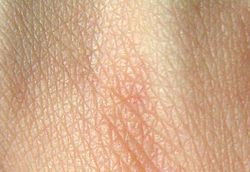Integumentary system facts for kids
Quick facts for kids Integumentary system |
|
|---|---|
 |
|
| Cross-section of all skin layers |
The integumentary system is like the body's outer shield. It's a group of organs that cover the outside of an animal's body.
This system includes your skin, hair, and nails. For other animals, it can also include scales, feathers, or hooves. The word integumentary comes from a Latin word, integumentum, which means 'a covering'.
The integumentary system works as a strong barrier. It helps to protect and keep the body healthy and safe.
Contents
What Makes Up the Integumentary System?
Your Skin: The Body's Largest Organ
Your skin is an amazing organ! It's actually one of the largest organs in your body. For humans, skin makes up about 12 to 15 percent of your total body weight. It covers a large area, about 1.5 to 2 square meters.
Your skin is made of at least two main layers of tissue. These are called the epidermis and the dermis.
The Epidermis: Your Outer Shield
The epidermis is the very top, outermost layer of your skin. It's super strong! Think of it as your body's first line of defense. It protects you from things in the outside world.
This layer is separated from the dermis by something called the basement membrane. The epidermis also has special cells called melanocytes. These cells give your skin its color. The deepest part of the epidermis also has nerve endings. These help you feel things.
The cells in your epidermis contain a tough protein called keratin.
The Dermis: The Support Layer
The dermis is the second layer of your skin. It sits right below the epidermis and supports it. This layer is made of tissues like collagen and elastin. These proteins are arranged in a way that gives your skin strength and stretchiness.
The dermis has two parts: the papillary dermis and the reticular layer. These layers help your skin be stretchy and flexible. They allow it to stretch and then return to normal, resisting wrinkles and sagging. Blood vessels and nerves reach into the dermal layer. This layer also holds the roots of structures like hair and glands.
The Hypodermis: Your Energy and Insulation Layer
The hypodermis is a layer found just beneath your skin. It's right below the dermis. It's connected to the dermis by strong collagen and elastin fibers. This layer is mostly made of fat cells, called adipocytes. These cells collect and store fats.
The hypodermis acts like an energy storage tank for your body. The fats stored here can be used for energy when your body needs it. It also helps with keeping your body temperature steady. Fat is a good insulator, so it helps keep you warm!
How Does the Integumentary System Work?
Your skin has a very important job: protecting your body. It's your body's first defense against infections, changes in temperature, and other challenges. It helps keep your body in a balanced state, known as homeostasis.
Here are some of its main jobs:
- It protects your body's internal tissues and organs.
- It guards against harmful germs that can cause infections.
- It stops your body from losing too much water and getting dehydrated.
- It helps protect your body from sudden changes in temperature.
- It helps get rid of waste materials through sweating.
- It acts as a sensor for touch, pressure, pain, heat, and cold. This is part of your Somatosensory system.
- It helps protect your body from sunburns by making melanin, which gives skin its color.
- It helps your body make vitamin D when exposed to ultraviolet light from the sun.
- It stores water, fat, glucose, and vitamin D.
- It helps maintain your body's shape.
- It can repair minor injuries by making new cells.
- It protects you from harmful UV rays.
- It helps control your body temperature.
- It separates and protects your body from its surroundings.
Your skin also has special sensory receptors. These receptors help you feel pain, pressure, and temperature.
Common Skin Issues and Conditions
Sometimes, the integumentary system can have problems. Here are some common conditions that can affect human skin:
- Acne (pimples)
- Albinism (lack of skin color)
- Athlete's foot (a fungal infection)
- Atopic dermatitis (a type of Eczema)
- Cancer (like Skin cancer)
- Eczema (itchy, inflamed skin)
- Herpes (a viral infection)
- Herpes labialis (cold sores)
- Impetigo (a bacterial skin infection)
- Infections (from germs)
- Psoriasis (a skin condition causing red, scaly patches)
- Rashes (irritated skin)
- Rosacea (redness and bumps on the face)
- Rubella (a viral infection causing a rash)
- Sunburn (skin damage from the sun)
- Yeast infections
See also
 In Spanish: Sistema tegumentario para niños
In Spanish: Sistema tegumentario para niños



